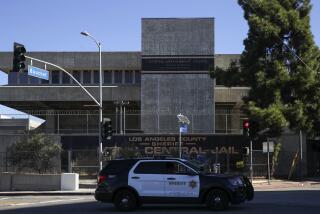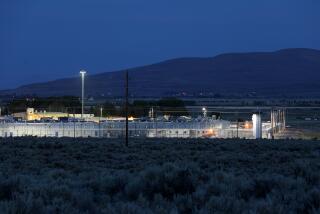Otay Mesa Prison Plan Mired in Confusion After Passing Go
- Share via
SACRAMENTO — State prison officials got the legislative go-ahead Wednesday to finally begin work at the site of a proposed state prison on Otay Mesa next month, but the decision immediately became mired in parliamentary confusion.
At the end of a long and heated debate over security at the proposed new 2,200-cell facility, the chairman of the Joint Legislative Committee on Prison Construction and Operations said work could begin, and prison authorities said they were eager to get started.
But another member of the committee, Assemblyman Richard Floyd (D-Hawthorne), disagreed--and sought the Legislature’s lawyer for a legal opinion.
The committee’s chairman, Sen. Robert Presley (D-Riverside), announced that work could begin after the panel held three inconclusive votes regarding fencing and a guard-tower spacing plan.
Although the last vote was 3-2 favoring the Corrections Department’s plans for 12 guard towers 700 feet apart, Presley declared that the motion failed because two committee members from each house--the Assembly and the Senate--must approve prison construction plans.
With several committee members arguing for fewer towers as an economy measure, Assemblyman Larry Stirling (R-San Diego) was the only Assembly member to favor the department’s tower and fencing plan.
Nevertheless, Presley said the prison work could proceed because a 1983 statute governing the six-member committee says department work plans are considered approved when the committee takes no action on them.
If all that seems confusing, it was also unclear to Floyd, who asked for a vote on the department’s plan, thinking that its failure would force another delay before work could begin on the $139-million facility near the Mexican border.
Floyd wanted work stalled because of still unsettled questions regarding the handling of sewage at the new prison, which he said could create serious health problems. To move ahead before a permanent sewage solution is worked out is irresponsible, Floyd argued.
But Stirling and Corrections officials said those problems can be solved.
Department of Corrections spokesman Robert Gore said local and state officials essentially reached an agreement regarding the handling of sewage on Friday and that the agreement was being put into writing.
But committee members sensed a disagreement between Stirling and Corrections officials over whether a $2.5-million payment by the state to the City of San Diego entitled the new prison to hook into the city plant at Point Loma for five years, or permanently if necessary.
Stirling, who said he will introduce new legislation soon to build a permanent on-site sewage treatment and water reclamation facility at new prison, said the Point Loma hookup would be temporary and that the prison’s own system will be in operation within five years.
But prison officials said the agreement is written so that they could continue to use the Point Loma facility should the on-site reclamation project prove unfeasible.
Stirling, who said he was convinced that the reclamation is feasible, told committee members there was no substantial disagreement between him and prison authorities, just different “levels of optimism.”
Prison spokesman Gore said officials hope workers will be clearing brush and beginning grading at the site by April 30.
But he said officials do not intend to begin fencing or other construction work until the sewer agreement is signed and approved by the committee.
The proposed prison has been planned for more than five years and was scheduled to open this summer. But no work has begun.
More to Read
Sign up for Essential California
The most important California stories and recommendations in your inbox every morning.
You may occasionally receive promotional content from the Los Angeles Times.










